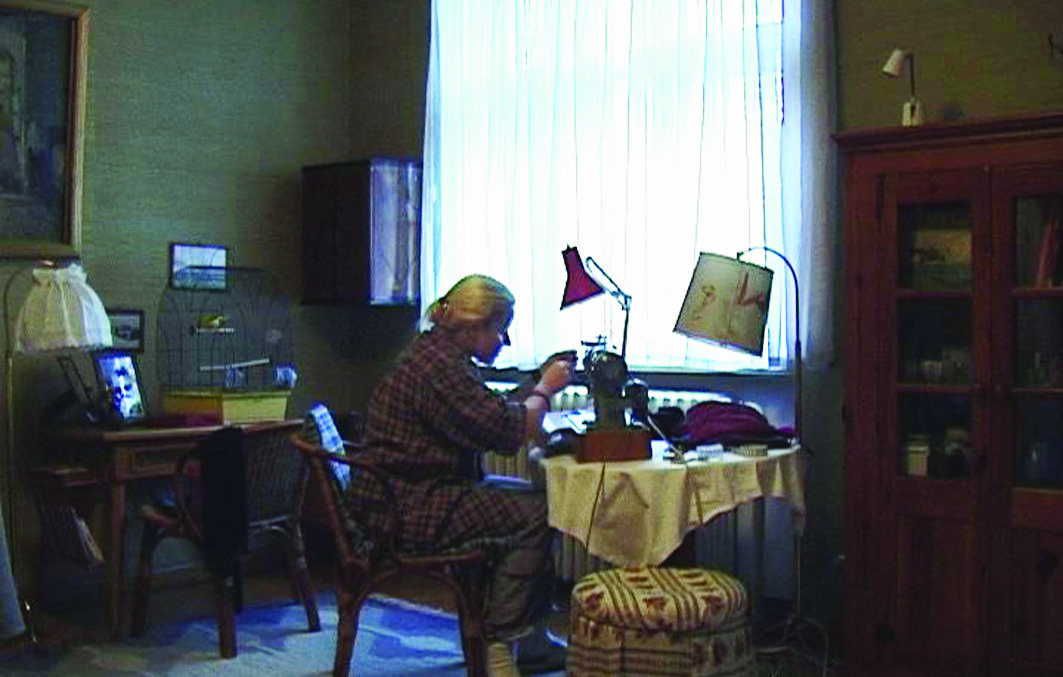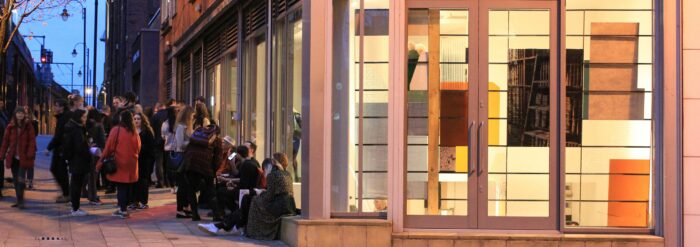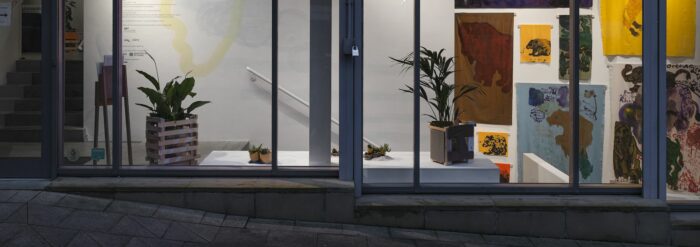
PureScreen #12: A Haunting
PureScreen #12: A Haunting
28 October 2005
17:00 - 18:00
The expectation of the worst can govern our strongest emotions; it is a base instinct at the heart of our existence. Fear informs how we live now – whether preparing for the worst by anticipating it in our everyday lives, or indulging ourselves in it as a form of entertainment. We titillate ourselves with fear, but when faced with the real thing we are reminded of its power. This screening event will explore cinema’s manipulation of film audiences and their relationship to fear and suspense. It will investigate the effect that the unknown has upon us, whether this is in the memory ‘recorded’ in the stones of a building, in the movement of the ether around us or in the legacy of legend and superstition. FEATURING ARTISTS: Cathy Akers, Marco Bowald & Jean-Claude Campell, Susanne Burner, Jacob Cartwright & Nick Jordan, Alexandra Dipple, Stephen Gunning, Ruth Hopwood, Mikyoung Jun Pearce, Ingrid Lindberg, Kjersti Sundland, Alison Ward. PROGRAMME NOTES: Cathy Akers Ever After (2.10) Fairy tales and horror movies, with their ability to produce fictional worlds that operate on a primal level, activating our most secret fears and desires, are a source of fascination for Akers. Ever After is set in the woods, a common staging ground for the most dramatic moments of both horror movies and fairy tales, and explores the narrowly defined roles that young women play in both genres, re-examining and re-inventing the figure of the heroine. Susanne Bürner Ohne Titel 3 (6.10) The fixed camera’s constant view allows us to gain insight into apparently ordinary room situations. A girl sits in a waiting room and reads. A woman works at a sewing machine in her living room. In some exclusively furnished apartment the television is on. The scenery seems clear and controlled, almost trivial. Yet there is a disruptive element, evoked by the sparkling unreality of the light that shines through the large windows into the three rooms. The curtains, flapping and flickering in high frequency, seem to announce the mysterious. Natural sounds mix with distorted, unpleasant interference and horror film conversation scraps, increasingly heightening the expectation of the unexpected and nourishing the imagination. The inexplicably electrified mercilessly remains in the room sceneries. But nothing happens. The disturbing is continuously getting ordinary. Only the much shorter fourth and last shot offers hints for a narrative conclusion. The room is a mess, a chair has fallen over: something must have happened. There is still this flickering in the windows-it seems to be normal. Jacob Cartwright & Nick Jordan Edgar (1.30m) Soon again I heard a tapping somewhat louder than before. `Surely,’ said I, `surely that is something at my window lattice; Let me see then, what thereat is, and this mystery explore – Let my heart be still a moment and this mystery explore; – ‘Tis the wind and nothing more.’ – from Edgar Allen Poe, The Raven Alexandra Dipple Ex Uno Plures (2.00) The film comprises two short from ‘Poltergeist 2’ cut in half down the middle then spliced together: the first section shows Carol-Anne, sitting in a lush summer garden surrounded by flowers. The girl is white and blonde, an exaggerated almost kitsch picture of childhood innocence. She’s playing a counting game, head down, totally engrossed, enjoying the beautiful day and the security of her happy family off screen. The second section shows the same little girl this time looking up, straight into the camera, momentarily disturbed by a sinister preacher who is walking up the suburban drive towards her. The preacher, (not seen in the film) represents an unspecified threat, which I use to symbolise knowledge, or revelation. As the preacher, approaches it starts to rain and the sunny day turns grey and overcast, it is the juxtaposition of the two clips that creates the intensity. The film describes a fascination with that moment of revelation and because it continually repeats on a loop, an inability to move beyond it. Stephen Gunning Re-lapse (10.00) A film made in collaboration with Grigori Lotman, which was produced as part of the Moks Arts Symposium in Mooste, Estonia. The film was shot in an old Russian oil container over a period of two days. In the film, Grigori, a Russian immigrant living in this rural village resounds to the cameras with a lengthy, improvised performance. The resulting images and sound are woven together in a theatrical and abstract style. Evoking a sensation of private displacement, moments suspended in time by the latent temporal quality of the film loop. The sound of Grigori’s voice reverberating around the oil container intensifies the alienation and abandonment of the space of the viewer. Further unrecognisable sounds, or the reversed sounds of tin whistle and mouth organ add to the unsettling, frantic feel, empty noise and heightened presence that the work possesses. Ruth Hopwood Blonde (1.21) As the fear of the ‘Blonde’ is watched, the viewers’ own suspense is encouraged through the soundtrack. The intensity with she is re-living her memories, and the glimpses we catch, indicate a very real terror. The voices say that ‘they’ are coming although we are never told whom. The source of the blonde’s haunting could be traced back to any number of horror film subjects although the most befitting would be a personal choice. Whatever it is for this heroine, the danger may not be past…. Ruth Hopwood Silly Boy (1.08) While being told there is nothing to be afraid of, the viewer of ‘Silly Boy’ might feel otherwise. The young boy’s voice alternates between disdain and concern, raising questions as to what it is that might be causing fear and the validity of that emotion in relation to reality. Ideas of memory, and tensions between past and present, also provide a starting point for thinking about the nature of fear, how it is produced and sustained. Ingrid Lindberg Alien – Watcher (3.00) A portrait of the artist with her face regularly darkened by monster sounds from the film ‘Alien’; experimenting in confronting and expressing the personal film experience / traumatic event. (Sound from Ridley Scott’s ‘Alien’ © 20th Century Fox) Mikyoung Jun Pearce Shhh (1.03) This text-based piece is presented as a one-way conversation between the screen, or the unnamed entity behind the words, and the viewer. Opening with title, it begins with a series of commands to ‘come her’ and ‘keep quiet.’ From the title onwards there is evidently an element of fear and paranoia behind the unheard command voice. This is accentuated later in the piece as the viewer is told to ‘go and hide’ from an unnamed outside ‘they.’ Finally the viewer is told that they ‘better leave’ in case ‘they’ come back. Kjersti Sundland A Dual of Giants (10.00) The video travels through a film-historic terrain, by referring to Sadako’s hidden face, in Hideo Nakatas Ring-trilogy, the girl in the Poltergeist movies, and how the daughter’s death at the beginning of Nicoloas Roeg’s Don’t Look Now, with her ghost-like presence, ends with catastrophic consequences. As these references indicate, Kjersti Sundland is making use of conventions and references from the horror genre, but those are first of all used in order to show us the horror in the repetition of genre stereotypes. If we take a closer look at the horror genre, boys are often portrayed as inverts of the male character in the mainstream-cinema and its heroic pose. This becomes clear in the Omen-series; here the boy is the son of Lucifer, a direct manifestation of the evil. In contrast, girls are as a rule, possessed. The evil is seldom identified with the girl; it remains outside of her control, which is being underlined by her becoming a different person, when the wickedness takes root of her. The exorcist is an illustration here, even if he little girl is the movie’s demonical centre, it is not she who is the active subject, but the demon, who speaks through her. In Sundland’s video, we experience the same discomfort as we find in the horror-genre, but the characters still do not play out a story of possession, but occupies, through their non-controlled bodies, this affected attitude in loop. Thus, it is not an illusion of possession that we see in Sundland’s work, but an insistence on the necessity of reflection over this structure, as a reflection of the other, often patriarchal representation systems of the society. In this sense, the girl poses are mantras, which, by referring to the stereotypes of the horror movies, require, that we evaluate them in a wider context. This context is not only the possessed girl, but any form of stereotype presentation of the body within the control-mechanisms, like we see them being operative in the school system, popular culture, and other sub-cultural icons of the feminine as an object of desire. (Thomas Kvam 2003) Alison Ward Into the Woods (3.00) Into the Woods begins in the style of a classic horror flick. A dark wood is accompanied by frantic panting that alerts us to the fear of the camera operator. All of a sudden, burlesque dancer wearing snarling wolf mask gyrating forward, adding an element of comedy and sex to the scene. She performs, and is gone. Two other she-wolves appear in the same manner as the first, becoming the predator. In the end, they descend towards the cameras, in a bloodthirsty feeding frenzy. Like much of Ward’s work, Into the Woods challenges traditional roles of masculinity and femininity. It transforms the story of Red Riding Hood, reversing the roles of victim and predator. Simultaneously, it uses humour to poke fun at societal constraints.

